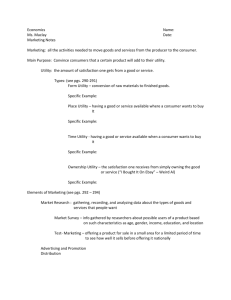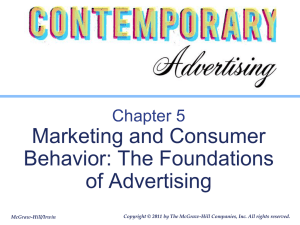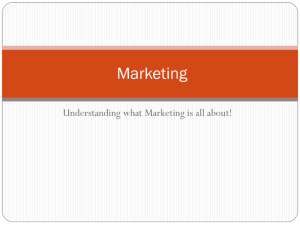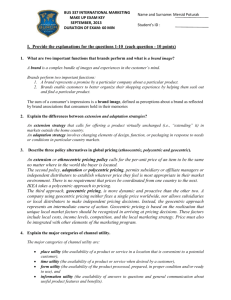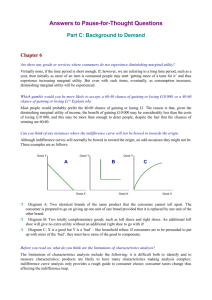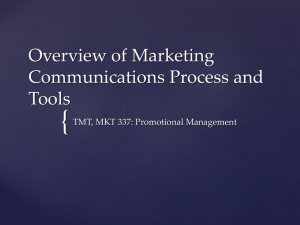Advertising & Marketing Smart Marketing IQ Quiz
advertisement
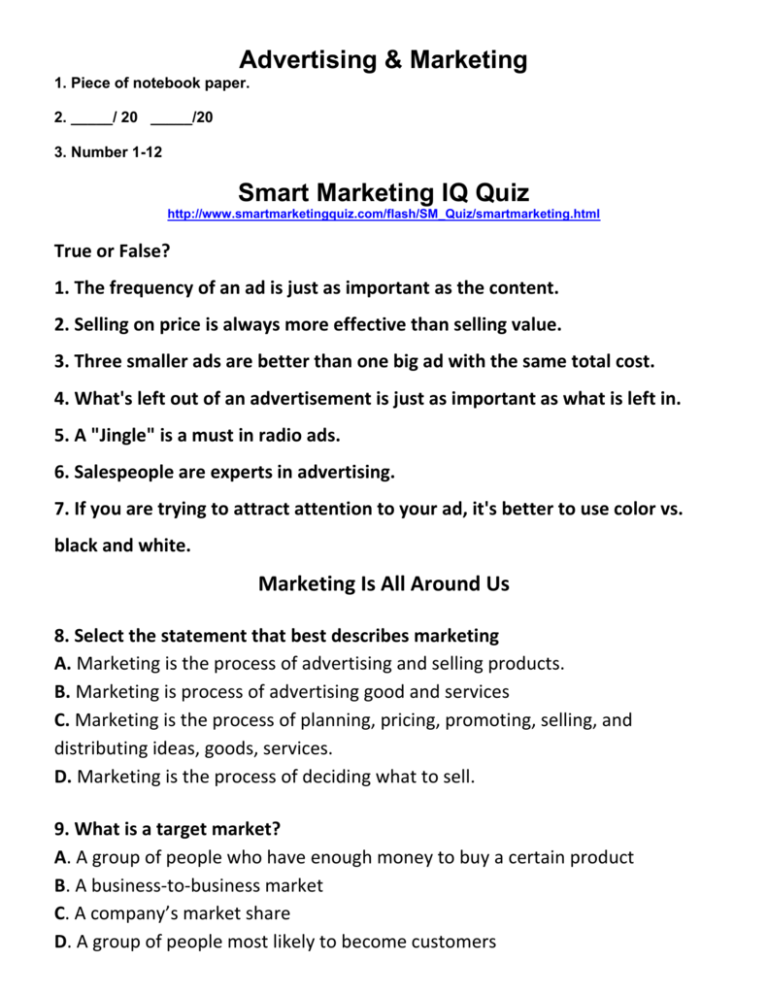
Advertising & Marketing 1. Piece of notebook paper. 2. _____/ 20 _____/20 3. Number 1-12 Smart Marketing IQ Quiz http://www.smartmarketingquiz.com/flash/SM_Quiz/smartmarketing.html True or False? 1. The frequency of an ad is just as important as the content. 2. Selling on price is always more effective than selling value. 3. Three smaller ads are better than one big ad with the same total cost. 4. What's left out of an advertisement is just as important as what is left in. 5. A "Jingle" is a must in radio ads. 6. Salespeople are experts in advertising. 7. If you are trying to attract attention to your ad, it's better to use color vs. black and white. Marketing Is All Around Us 8. Select the statement that best describes marketing A. Marketing is the process of advertising and selling products. B. Marketing is process of advertising good and services C. Marketing is the process of planning, pricing, promoting, selling, and distributing ideas, goods, services. D. Marketing is the process of deciding what to sell. 9. What is a target market? A. A group of people who have enough money to buy a certain product B. A business-to-business market C. A company’s market share D. A group of people most likely to become customers 10. What are the economic utilities that relate to marketing? A. Form utility, place utility, time utility, possession utility, and information utility B. Form utility, place utility, time utility, and promotion utility C. Market share, target market, and customer profile D. Distribution, financing, information management, product management, pricing, promotion, and selling 11. What are the components of the marketing mix? A. Form, place, time, possession, and information B. Product, place, price, and promotion C. Product, place, and price D. none of the above 12. What are the functions of marketing? A. Distribution and financing B. Pricing, selling, and product/service management C. Marketing information management and promotion D. All of the above Product Design Definition of ADVERTISING 1: the action of calling something to the attention of the public especially by paid announcements Advertising is a form of communication intended to persuade an audience (viewers, readers or listeners) to purchase or take some action upon products, ideals, or services. It includes the name of a product or service and how that product or service could benefit the consumer, to persuade a target market to purchase or to consume that particular brand. Advertising can also serve to communicate an idea to a mass amount of people in an attempt to convince them to take a certain action, such as encouraging 'environmentally friendly' behaviors, and even unhealthy behaviors through food consumption, video game and television viewing promotion. Advertising: The paid, public, non-personal announcement of a persuasive message by an identified sponsor; the non-personal presentation or promotion by a firm of its products to its existing and potential customers. Definition of MARKETING 1a : the act or process of selling or purchasing in a market b : the process or technique of promoting, selling, and distributing a product or service Marketing - is the social process by which individuals and groups obtain what they need and want through creating and exchanging products and value with others. Marketing is the management process that identifies, anticipates and satisfies customer requirements profitably. Marketing is the process whereby society, to supply its consumption needs, evolves distributive systems composed of participants, who, interacting under constraints - technical (economic) and ethical (social) - create the transactions or flows which resolve market separations and result in exchange and consumption. Now that you have been introduced to some definitions of marketing and the marketing concept, remember the important elements contained as follows: • Marketing focuses on the satisfaction of customer needs, wants and requirements. • The philosophy of marketing needs to be owned by everyone from within the organization. • Future needs have to be identified and anticipated. • There is normally a focus upon profitability, especially in the corporate sector. However, as public sector organizations and not-for-profit organizations adopt the concept of marketing, this need not always be the case. • More recent definitions recognize the influence of marketing upon society. The 4 P's of Marketing Marketing decisions generally fall into the following four controllable categories: • Product • Price • Place (distribution) • Promotion Marketing your business is about how you position it to satisfy your market’s needs. There are four critical elements in marketing your products and business. They are the four P’s of marketing. 1. Product. The right product to satisfy the needs of your target customer. 2. Price. The right product offered at the right price. 3. Place. The right product at the right price available in the right place to be bought by customers. 4. Promotion. Informing potential customers of the availability of the product, its price and its place.


